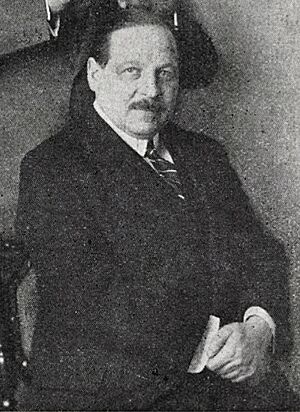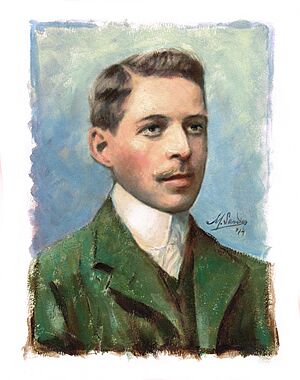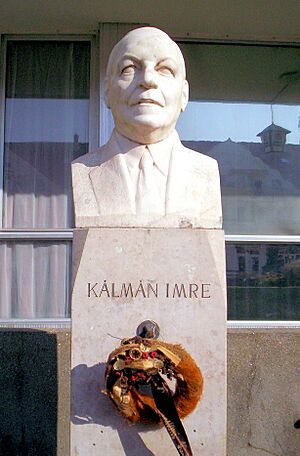Emmerich Kálmán facts for kids
Emmerich Kálmán (whose Hungarian name was Kálmán Imre) was a well-known Hungarian composer. He was born on October 24, 1882, and passed away on October 30, 1953. Kálmán was famous for writing operettas, which are like light operas with singing, talking, and dancing. He played a big part in making Viennese operetta popular in the 1900s.
Some of his most famous works are Die Csárdásfürstin (which means The Csárdás Princess) from 1915 and Gräfin Mariza (Countess Maritza) from 1924. His music was influenced by Hungarian folk music, like the csárdás dance. He also took inspiration from other Viennese composers like Johann Strauss II and Franz Lehár. Later in his career, he even added sounds from American jazz music into his work.
Because of a historical event called the Anschluss (when Nazi Germany took over Austria), Kálmán and his family had to leave Europe. They first went to Paris and then to the United States. He returned to Europe in 1949 and died in Paris a few years later in 1953.
His Life Story
Kálmán was born as Imre Koppstein in a town called Siófok in Austria-Hungary. This town is on the southern shore of Lake Balaton. His family was Jewish.
When he was young, Kálmán wanted to be a concert pianist. But he developed arthritis early in life, which made it hard to play the piano. So, he decided to focus on writing music instead. He studied music theory and composition at the Franz Liszt Academy of Music in Budapest. There, he was classmates with other famous composers like Béla Bartók and Zoltán Kodály.
His early orchestral pieces, Saturnalia and Endre és Johanna, were well-liked. However, he couldn't get them published. He also wrote piano music and many songs.
Kálmán became very popular for his funny cabaret songs. This led him to start writing operettas. His first big success was Tatárjárás, which means Autumn Maneuver in German. In English, it's known as The Gay Hussars. This operetta was first performed in Budapest on February 22, 1908.
After this success, he moved to Vienna, Austria. There, he became famous around the world with his operettas. These included Der Zigeunerprimas (The Gypsy Band Leader), Die Csárdásfürstin (The Csárdás Princess), Gräfin Mariza (Countess Maritza), and Die Zirkusprinzessin (The Circus Princess).
Kálmán and Franz Lehár were the most important composers of what is called the "Silver Age" of Viennese operetta. This period was during the early 1900s. Kálmán was known for mixing the Viennese waltz with the Hungarian csárdás dance in his music. He also admired composers like Giacomo Puccini for melodies and Pyotr Ilyich Tchaikovsky for how he used instruments in his orchestras.
In 1929, his first child, Charles Kalman, was born. Charles also grew up to be a composer.
Even though Kálmán was Jewish, he was one of Adolf Hitler's favorite composers. However, after the Anschluss (when Nazi Germany took over Austria), Kálmán refused Hitler's offer to be called an 'honorary Aryan'. Because of this, he had to leave his home. He first moved to Paris, France, and then to the United States, settling in California in 1940.
Later Life and Passing
After he left Europe, his music was banned in Nazi Germany. In 1949, he moved back to Vienna from New York. Then, in 1951, he moved to Paris, where he passed away.
In Popular Culture
In 1958, a West German movie called The Csardas King was made about his life. The main role was played by Gerhard Riedmann.
The fans of the national football and handball teams in Iceland use one of his compositions as their team song. It's called Das Veilchen vom Montmartre (The Violet of Montmartre).
His Operettas
Here are some of Emmerich Kálmán's most famous operettas:
- Tatárjárás (The Mongol Invasion) – Budapest, 1908
- Ein Herbstmanöver – Vienna, 1909 (German version of Tatárjárás)
- The Gay Hussars – New York, 1909 (American version)
- Der Zigeunerprimas (The Gypsy Band Leader) – Vienna, 1912
- Sari – New York, 1914
- Die Csárdásfürstin (The Csárdás Princess) – Vienna, 1915
- The Gipsy Princess – London, 1921
- Gräfin Mariza (Countess Maritza) – Vienna, 1924
- Countess Maritza – New York, 1926
- Die Zirkusprinzessin (The Circus Princess) – Vienna, 1926
- Das Veilchen vom Montmartre (The Violet of Montmartre) – Vienna, 1930
- Marinka – New York, 1945
See also
 In Spanish: Imre Kálmán para niños
In Spanish: Imre Kálmán para niños




